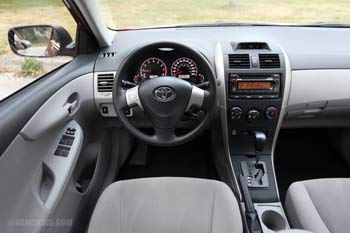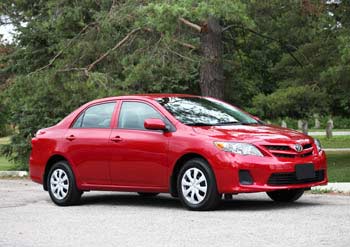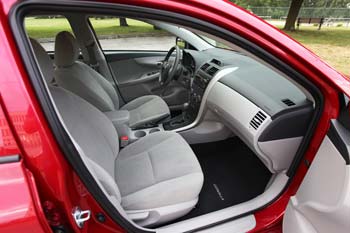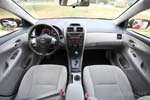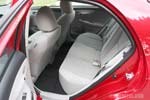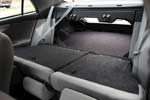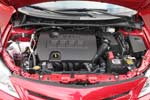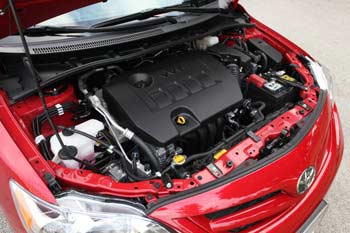Toyota Corolla 2009-2013: pros and cons, common problems
By Vlad Samarin Updated: March 11, 2023
The Corolla is known for its reliability, fuel-efficient 1.8L engine, simple roomy interior and soft ride. It's a comfortable little workhorse that you can count on.
The 2009-2013 Corolla is a front-wheel drive compact 4-door sedan, although the Toyota Matrix is a mechanically similar hatchback. The Corolla will last long with good care, but there are a few problems used car buyers should be aware of. Is it a good car to buy used? Let's start with pros and cons.
Pros:
- The Corolla is reliable and will last long with good care.
- Holds its value well and is easy to sell.
- Most of the common problems are not very expensive to repair.
- Simple and easy to work on for a DIYer.
- Good looks, comfortable interior, spacious trunk.
- Comfortable driving experience.
- The 1.8L engine is good on gas.
- Plain interior design.
- The 1.8L engine offers limited power and is noisy at higher speeds.
- The engine consumes oil at higher mileage.
Alternator problems: A failing alternator can cause the battery light to come on when the engine is running. When the alternator fails, the car battery can no longer be recharged. Read more about the alternator. Replacing an alternator in the 1.8L engine costs 0.8-1.0 hour of labor plus the part. Aftermarket parts are cheaper. Another option for a tight budget is a used part, but make sure it comes with the warranty.
Ignition coils: One of the ignition coils can fail, causing the engine to misfire. The Check Engine light may come on with codes P0301-P0304 or P0351-P0354 - the last digit of the trouble code is the number of the cylinder that misfires. The ignition coil is easy to replace. When replacing an ignition coil, it's a good idea to change all four spark plugs if they are old. An OEM ignition coil is priced between $86 and $139 online. Aftermarket parts are cheaper. Read more about ignition coils.
Water pump: The water pump is known to fail. The cost to replace the water pump ranges between 1.5 to 2.5 hours of labor plus the part. When replacing a water pump, it's a good idea to change the drive belt as well. Symptoms of a failing water pump include pinkish coolant drops around the water pump and a whining/buzzing or rattling noise coming from the water pump area. The water pump is located on the left side of the engine when looking from the front of the vehicle. See these videos for more info.
Oil leaks from the timing chain cover have been reported by several owners. See these YouTube videos explaining the repair.
Starter Motor: A failed starter motor can cause the car not to start. The common symptom is the starter will produce a single click, but won't turn over the engine even with a fully charged battery. Replacing a starter motor will cost you 0.8-1.0 hour of labor plus the part. Read more about the starter motor.
Driveline and Suspension: A bad wheel bearing can cause a humming noise that is more noticeable when driving at highway speeds. Replacing a wheel bearing can cost from 1.5 to 2.0 hours of labor plus the part.
Struts can leak at higher mileage. Replacing one front strut will cost 1.3-1.7 hours of labor plus the part.
Worn CV-joints can cause a clicking noise coming from the front wheels when accelerating while turning. If the CV joint is bad, the drive shaft is replaced as a unit in most cases. Replacing one drive shaft (axle) will cost 1.5-2.0 hours of labor plus the part.
Advertisement
The service bulletin T-SB-0087-09 for the 2009 Corolla / Matrix describes a problem where a brief knocking/rattling noise from the 2ZR engine when started cold is caused by a faulty camshaft timing gear assembly (VVT gear). The gear must be replaced to correct the problem. According to the bulletin, the repair labor is estimated at 1.5 hours. The part (gear assembly) is sold online for just over $200. If out of warranty, the repair could cost from $380 to $590.
The Check Engine light with the trouble code P0138 is often caused by a bad rear oxygen sensor. Replacing the sensor usually solves the problem.
Check for recalls at the NHTSA website.
Is the 2009-2013 Toyota Corolla a good car? Despite the problems mentioned above, the 1.8L Corolla is one of the most reliable compact cars and can last long with good maintenance. It's also good on gas; see fuel consumption numbers in the table below. As of July 2022, Consumer Reports rates the 2009 Corolla as 'average' for reliability, while the 2010-2013 Corolla is rated 'above average. Parts are not very expensive.
Even if the engine or transmission will need to be replaced at higher mileage, it won't be a problem to find a used unit for a reasonable price. The 1.8L engine is a better choice. The 2.4L engine had more potentially-expensive problems.
Among similar cars, we would also recommend the Honda Civic, Toyota Matrix and the 2010+ Mazda 3. Before buying a car check for recalls at Safercar.gov.
Engines: The base engine is a 132-hp 1.8L 4-cylinder DOHC, model 2ZR-FE. It's a proven simple and reliable motor. With good maintenance, it can last for well over 200K miles. The Corolla XRS comes with a 158-hp 2.4L 4-cylinder 2AZ-FE engine, shared with the Camry and RAV4.
Does the 2009-2013 Toyota Corolla have a Timing Belt or Chain: Both the 1.8L and 2.4L engines have a timing chain; there is no timing belt. The timing chain doesn't need to be replaced unless there is a problem with it. To make the timing chain last longer, check the oil level between oil changes and top up if needed; the chain wears faster if the oil level is low. At higher mileage, the VVT gear and/or the timing chain may need to be replaced if noisy. Here are a few videos showing the repair.
Engine Oil Capacity (Drain and refill with filter):
1.8L 4-cylinder (2ZR-FE) engine: 4.4 US qt. (4.2 L, 3.7 Imp. qt.)
2.4L 4-cylinder (2AZ-FE) engine: 4.0 US qt. (3.8 L, 3.3 Imp. qt.)
What to look for when buying a used 2009-2103 Toyota Corolla? When checking a used Toyota Corolla, watch out for the low engine oil level or a blue smoke from the exhaust when the engine is started; it's an indication that an engine consumes oil. Also look for another car if the engine rattles too loud. Watch out for coolant leaks or low coolant level. If you are buying the Corolla with the 2.4L engine, avoid the car if you notice coolant leaks from the head gasket area at the back of the engine.
During the test drive, watch out for rough shifting of the transmission; all shifts should be smooth.
Year to year changes: Toyota Corolla got a minor facelift for 2011 with a new front grille, head- and taillights, updated bumpers and trunk lid. For 2012, the Corolla received a few feature upgrades, including a new standard audio system with a USB port, Bluetooth and steering audio controls for the U.S. and Canadian LE trim. The U.S. Corolla L received power windows, power door locks and remote keyless entry.
Trim levels: In the U.S., the 2009 Corolla was offered in the base, S, popular LE, upscale XLE and sporty XRS trims. The XLE and XRS were discontinued for 2011 and the L trim became the base level for 2012.
Mechanical: The Corolla XRS has disc brakes on all 4 wheels; other models come with rear drum brakes that are known to last long. The steering is electrically powered. Antilock brakes are standard. Vehicle Stability control is optional in early models; standard on all U.S. models from 2010. The Canadian Corolla received standard Vehicle Stability Control for 2011.
Handling and ride: The Corolla is easy to drive. The ride is soft and quiet; cracks in the pavement and bumps are well absorbed by the suspension. The 1.8L engine has enough power for daily commuting and for long road trips. The electrical steering is light and feels fine in the city, but is a bit vague around the center position when driving on the highway.
Related reviews:
Toyota Corolla 1998-2008
Honda Civic 2012-2015
Honda Civic 2006-2011
Toyota Camry 2007-2011
Toyota Matrix 2009-2014
Pontiac Vibe 2003-2010
Chevrolet Cruze 2011-2015
Mazda 3 2010-2013
Toyota Corolla 2014-2018
Dodge Dart 2013-2016
Mazda 3 2014-2018
Photos:
Fuel Economy: The EPA rates the 2010-2012 1.8L Corolla auto at 26/34 mpg (9.0/6.9 L/100 km), which means that with mostly highway driving you can get up to 380 miles (612 km) on a 13.2-gallon (50.0L) tank.
| Toyota Corolla EPA Fuel Economy: | mpg city/hwy |
L/100 km city/hwy |
| 2009 1.8L auto | 27/35 | 8.7/6.7 |
| 2011 1.8L manual | 27/34 | 8.7/6.9 |
| 2009-2010 1.8L manual | 26/35 | 9.0/6.7 |
| 2012-2013 1.8L manual | 27/33 | 8.7/7.1 |
| 2010-2012 1.8L auto | 26/34 | 9.0/6.9 |
| 2013 1.8L auto | 26/33 | 9.0/7.1 |
| 2013 1.8L auto | 26/33 | 9.0/7.1 |
| 2009-2011 2.4L auto | 22/30 | 10.7/7.8 |
| 2009-2010 2.4L manual | 22/30 | 10.7/7.8 |
| 2011 2.4L manual | 21/30 | 11.2/7.8 |
